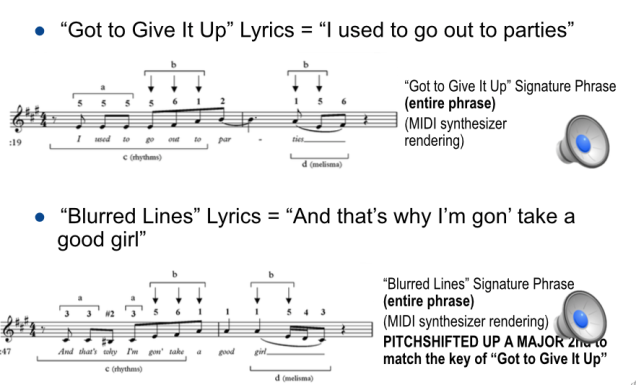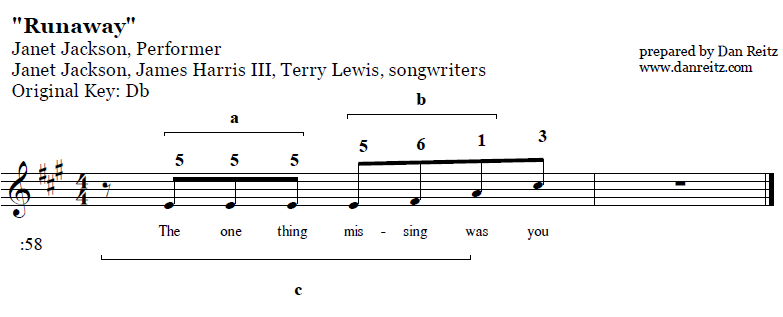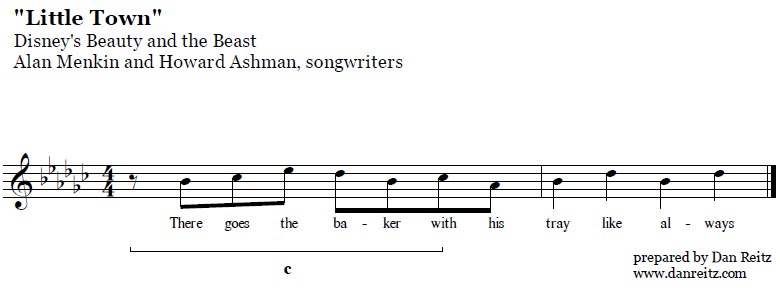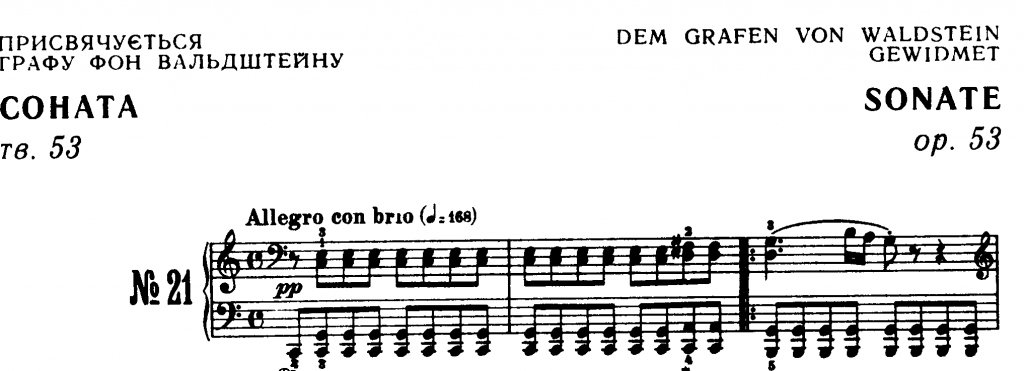Update (Mar 13 9:15 AM): This article is now somewhat out of date; after the verdict, I received access to most of the media used by the Gaye family’s legal team. These melodies were not the only things compared at trial, so this is an incomplete article. Stay tuned. In the mean time, this analysis is still accurate.
Update (Mar 13 4:30 PM): There is now a part 2.
Court has been called back into session in the Blurred Lines plagiarism lawsuit, and as far as I can tell, the plaintiffs are currently making their case. Gaye’s camp does not have much to go on, since the judge ruled that the full recordings of the original songs could not be played in court, but their case looks stronger than I thought it would. According to Kate Conger at Ratter, the musicologist hired by the Gaye family presented the following slide in court last week:
With this slide the musicologist puts both melodies in the same context; and proves that they share the following elements:
- a: a melodic fragment of three repeated notes (but not on the same scale degree)
- b: a melodic fragment consisting of the 5th, 6th, and 1st scale degree in upwards motion in eighth notes
- c: a rhythm of six repeated eighth notes preceded by a rest
- d: a melisma (a phrase where one vowel sound is continued over more than one note) that contains a descending fourth (the second b)
Although this is a much more compelling case than I was expecting, these elements are far from novel, and I can’t see how this case could be won by the Gaye family without opening the door to a wave of lawsuits and copyright trolling. Take those a and b melody fragments of Got To Get It Up, for example, notated here as “5-5-5” and “5-6-1.” Together they are also the melody of the opening phrase of the chorus to Janet Jackson’s song Runaway:
They’re also basically the opening piano melody to Smokey Robinson’s You Really Got a Hold On Me:
(*In this case phrase a is reduced to one note on the 5th scale degree, however phrase b continues onto the 2nd and then 1st scale degree, as is the case of Got To Give It Up.)
That eighth note rhythm indicated as c is also extremely common,which makes me wonder why it’s even being considered as part of the lawsuit. Here it is in Beauty and The Beast:
Here it is in Old Time Rock and Roll:
And in the opening phrase of Beethoven’s Waldstein Sonata:
So even though the musical material labeled a, b and c is all relevant to the case, I don’t think there is enough here to warrant a verdict in favor of Gaye’s family. These are common melodic and rhythmic ideas. I have only been working at this for about an hour and have already came up with one example that is an exact match for the Gaye a, b and c; one match for b and c that contains a fragment of a, and three rhythmic matches for c. This can be contrasted with the Sam Smith / Tom Petty plagiarism case, where my $180 prize for a third exact match that predates those songs has yet to be claimed despite a response from my friends that would lead me to estimate at least 15 man-hours have been spent looking for one.
You may be asking “what about the musical material labeled d and the second b?” The fragments that the musicologist is labeling d and the second b are irrelevant, I think; melismas are frequently improvised, and besides, they are different melismas. You can’t copyright the broad idea of including a melisma that contains a descending fourth.
Bright Tunes Music v. Harrisongs involved two recordings that had the same three- and five-note melodic fragments. In his ruling the judge in that case decided that using the same three- and five-note fragments on their own was not novel enough to be copyright infringement, but that “the four repetitions of A, followed by four repetitions of B, is a highly unique pattern.” So the copyright was violated not because a few notes were the same but because each of those fragments were repeated in the same way in each song for a total of twenty-seven shared notes in a row between the two songs. This is clearly not happening with Blurred Lines; there are only three (arguably five) notes that match each other exactly, and they are not repeated.
All things being said, this case is a lot closer than I thought it was going to be, and the Gaye family’s chances depend on on the jury’s perception of all of this. We are in fairly murky waters, but based on my understanding of our copyright laws and the precedent set by Bright Music v. Harrisongs, this is not a case of plagiarism. If the jury does rule in favor of the Gaye family, things are about to get very interesting. The Gayes’ musicologist has chopped the music up into pieces that are so small that it would fundamentally change the process of songwriting if they won. If three common notes within a single similarly-shaped phrase is all that is needed to successfully sue someone, then the floodgates of litigation are about to swing wide open. Stay tuned.






19 replies on “Analyzing the case against “Blurred Lines””
And wide-open they’ve been flung. Great analysis. Wish you were on the jury.
Nice work! Clear and to the point without rambling on. I don’t know why the jury made their decision, maybe they liked the memory of a classy Marvin Gaye over the Personality of Thicke.
Bingo.
No, it’s because the nicking happened – just not in the melody. The theft is screamingly obvious to any musician.
Thank you, Robert. People are trying to make me think I’m crazy for seeing for how this is about more than just a melodic fragment.
Thank you, Robert. People are trying to make me think I’m crazy for seeing how this is about more than just a melodic fragment.
You guys are right: the case is not just about these two melodic fragments. There is now a Part 2: http://danreitz.com/blog/2015/blurred-lines-case-analysis-piano-arrangements/
The name of that “Beauty and the Beast” song is “Belle” rather than “Little Town”.
Thanks! My bad.
[…] reaction upon seeing that they had been ordered to pay the Gaye estate 7 million smackers. But Dan Reitz and Michaelangelo Matos convince me that it’s a really terrible […]
@xor turned me on to this post, and I’m really glad to have read it.
The thing is that this sort of dissection is permissible, but only to prove “extrinsic similarity” (in the Ninth Circuit’s odd way of analyzing substantial similarity). Extrinsic similarity is roughly the equivalent of “probative similarity” that the Second Circuit sometimes uses, which make it related to the question of access: not must the copyright holder prove exposure but also that the alleged infringer took *something* from underlying work. Where proof of access is very high, as it is in the “Blurred Lines” case (which is very unusual), the proof of extrinsic similarity can be low. Once the jury finds access and extrinsic similarity, then it’s on to intrinsic similarity, which is essentially a gut check (the actual jury instructions say “total concept and feel”). I say a bit more here: http://ipbreakdown.com/blog/the-lines-of-copyright-infringement-have-always-been-blurred/. But the bottom line is that this case is highly unusual because it represents a perfect storm of easy proof of access, a big hit, heirs and at least one terrible witness (guess who). So that’s how we ended up with the verdict we got.
One little nit: the “My Sweet Lord” case isn’t really precedent, in that it doesn’t necessarily represent the floor of substantial similarity. All we can say is that it’s what one court thought after receive certain evidence, but it doesn’t exclude the possibility of a finding of copyright infringement where there is less similarity.
Just read your blog, Rick Sanders. Thanks – excellent and I get it now.
I read that Thick was able to play portions of hit songs and show the jury how common it is for similarities to exist. I can’t help but wonder what else played into their decision.
Good work Dan. The amazing thing about these examples is that there is only one spot in which the same note appears at the same location: the E on the 3rd beat of the second bar. These are completely unrelated melodies, different start, middle, ending, and rhythm. Notes are cherry picked and skipped over to draw parallels in the example. The bracketed figure “a” does not even exist in Blurred Lines, the musicologist had to skip a note to make this parallel, so it is irrelevant to plagiarism. These melodies will clash in places if sung together. This example would provide much better evidence that these are two completely different melodies. This is as far from plagiarism as it gets.
I’m looking forward to the appeal. This case should not have even made it in front of a jury.
Agreed!
[…] are in two different keys. One of the arguments made in court was the similarity in the melodies. This blog post shows the pitch elements in question, and demonstrates how tenuous the connection is. Have you ever been whistling a tune and then you […]
An interesting question regarding the whole “vibe” of the song issue is: did Marvin Gaye actually write the arrangement, or was it his producer Art Stewart, or a hired-in arranger, or was it something that just kind of came about in the room when they were rehearsing?
I’ve thought this too, and that question brings to mind the case of the Clyde Stubblefield and the Funky Drummer loop: http://www.nytimes.com/2011/03/30/arts/music/clyde-stubblefield-a-drummer-aims-for-royalties.html?_r=0